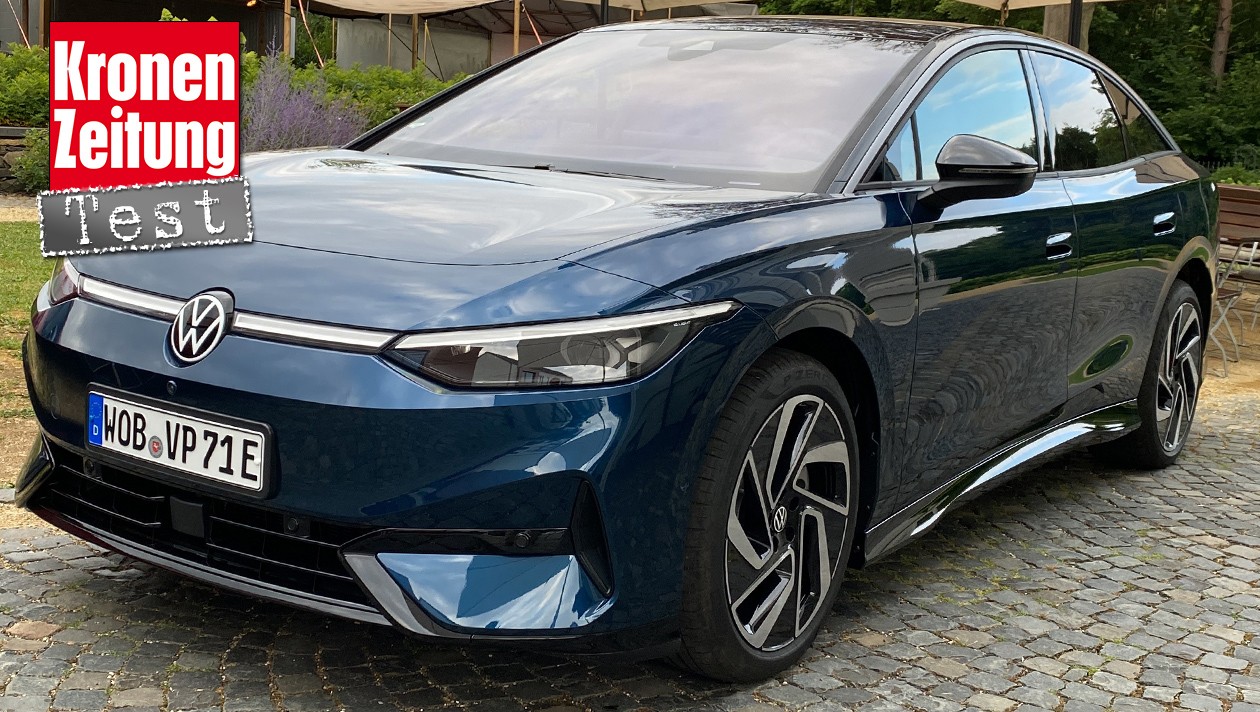Volkswagen is launching the new Wolfsburg flagship in autumn: the VW ID.7. The almost five-meter sedan offers plenty of space and promises considerable ranges. They also addressed some criticisms, though not all. As part of a German Car Awards event, “Krone” motor editor Stephan Schätzl had the opportunity for a first check and test drive – his impressions here in the video!
The ID.7 is the largest car on VW’s electric platform: 4.96 meters long and 2.97 meters wheelbase ensure opulent space. 532 liters of luggage fit in the trunk. The look with the friendly ID face fits seamlessly into the row of the siblings, but the roof line is 1.54 meters flatter than in any other ID model. That’s good for drag (frontal area: 2.45 m²), although the drag coefficient isn’t quite as good as one would expect given the shapes. There is a continuous strip of lights at the front and rear. Much new in the interior The interior appears quieter than in the other ID cars, only the attached 15-inch touchscreen still looks like a foreign body. This is particularly due to the protruding bar underneath, which contains the unloved touch sliders for temperature and volume. At least they are lit now. Behind it, a continuous band runs across the dashboard, which contains the intelligent air vents. The small, very clear speedometer display was integrated or embedded in this band, which appears much more coherent and of higher quality than the Kastl placed on it in the other IDs. The size is sufficient because further information is shown in the standard head-up display. The mirrored display is designed so intelligently that it does not appear bulky and does not distract the driver. Augmented reality functions provide additional support: The lane departure warning system in the windshield puts a yellow line on top of the one you are driving over and navigation arrows fly towards the driver, so to speak. The lane marker now also works without road markings. VW has not yet been able to heed one criticism of the operation: the steering wheel still has touch elements that are difficult to operate instead of the buttons promised by VW boss Schäfer. These will initially only be introduced in combustion models. In the IDs, it will take about two years because the development effort is higher here. The small door console for mirror adjustment and window lifters, which is prone to operating errors, is also still in use. The controls for the windshield wipers migrated to the likewise bulky turn signal lever. A good climate is ensured. The air conditioning plays a few pieces. The air flow is controlled via the display and can be directed towards the body or distributed diffusely with a tap of the finger. In addition, the nozzles have a kind of weaving function, as is known from room air conditioning systems. The air conditioning begins as soon as the driver approaches, so on a sunny day you get into a car that is already slightly cooled. The optional top seats not only have the seal of the Healthy Back campaign, they also have seat heating and ventilation – and also temperature and humidity sensors. You can therefore identify any need for cooling or heating. What’s more: You can also tell whether the driver is sweating and can start a drying program automatically or if you wish – like an integrated hair dryer. New, powerful drive The newly developed electric motor has an output of 210 kW/286 hp and delivers a maximum torque of 545 Nm. With the net 86 kWh battery, around 700 kilometers WLTP range is promised. The smaller battery is good for 615 kilometers with its 77 kWh. It is charged with 200 or 170 kW at 400 volts. The top speed is 180 km/h. The ID.7 is built at the VW plant in Emden. The market launch in Europe is planned for autumn 2023.
source site-13
